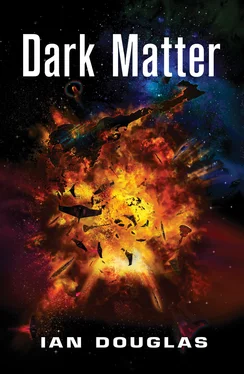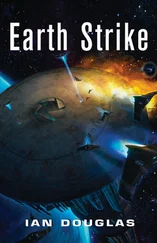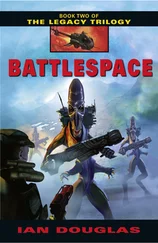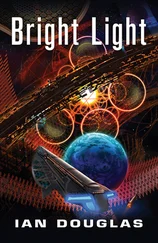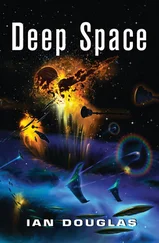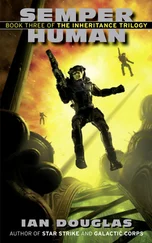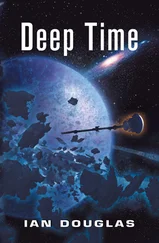Data flowed into Gregory’s in-head, and he opened an inner window to view it. He saw again the crowded inner reaches of the Omega Centauri cluster, millions of brilliant stars filling the sky, and, ahead, the blurred and eerie doughnut of blue light and gas, turned almost edge-on, set in an infalling swirl of hot dust and tortured hydrogen atoms. Shadowy, vast structures hung in the distance, made indistinct by the dust . . . the stellarchitecture of the Rosette Aliens. America’s fighter squadrons had flown CAP over the past several days—the term was from combat air patrol, an anachronistic holdover from the days of wet navies and atmospheric fighters—but never approached the Rosette. It would be kind of nice, Gregory thought, to actually see up close what all of the fuss and scuttlebutt was about.
The blurred disk grew larger, and the angle shifted as Walton’s ship approached, giving them a line of sight into the Rosette’s interior. Gregory saw scattered stars . . . a black and empty night sky . . .
“We’ve slowed down the images by a factor of ten,” McCabe told the audience. “Lieutenant Walton was only over the Rosette for a few seconds, but by slowing down the feed we can see details that are not, at first, apparent. What we’re looking at here, obviously, is deep space . . . but you can see that it’s not the space within the cluster. The stars are few and far between. This particular line of sight, we think, lets us look through to a region out on the galactic rim.”
One by one, the other spaces recorded during Walton’s passage came into view, each replacing the one that had gone before. The heart of a nebula . . . various starfields . . . the mottled, close-up surface of a red sun . . . a scattering of distant galaxies . . .
The final scene was of a searing field of radiant blue light, as though the line of sight was plunging into the heart of an exploding sun.
McCabe froze the image there. A new window opened to one side, one showing the familiar blurred cylinder of a TRGA. The two images floated next to each other in Gregory’s mind at identical angles, allowing a close comparison.
“Despite the obvious physical differences,” Commander McCabe went on, “the Rosette is a transport mechanism quite similar to the TRGAs, except for the size, of course. A TRGA, we now know, is a kind of everted Tipler machine. The original device—the theory, rather—was developed in 1974 by a physicist named Frank J. Tipler. According to him, a cylinder of extremely dense matter rotating at near-light velocity would drag the spacetime fabric around it in a way that would permit what physicists call closed, timelike curves, creating gateways or portals across vast distances of both space and time. Two decades later, physicist Stephen Hawking demonstrated that closed, timelike curves were impossible, as was time travel.
“Evidently, the TRGA Builders did not read Hawking. Instead, they seem to have turned the idea inside out, creating a hollow cylinder about a kilometer across, with solar-sized masses rotating around the cylinder’s axis within the walls. A number of distinct paths through the interior of the cylinder result in spacial displacements of, in one case, several tens of thousands of light years—and a temporal displacement of eight hundred seventy-six million years. The Agletsch refer to the TRGAs as Sh’daar Nodes. However, we know that the Builders were not the modern Sh’daar, but instead they were, hundreds of millions of years ago, the ur-Sh’daar, the ancient community of highly advanced civilizations inhabiting the small, irregular galaxy called the N’gai Cloud.
“Which, of course, brings us to the Black Rosette.”
The TRGA image vanished, and the in-head image expanded slightly, closing in on the Rosette’s eldritch maw. Harsh blue light glared from the opening.
“The Rosette,” McCabe continued, “appears to be an expansion of TRGA technology . . . but on a far vaster scale. Six black holes, each fifty times the mass of Sol, rotating about a common center of gravity at high speed, creating a gateway nearly one hundred thousand kilometers across.”
A second window opened once again, this time showing a perfect circle of six brilliant, sapphire-blue suns—the Six Suns, encountered by America’s task force in the N’gai Cloud in the remote past.
“The Rosette is at least nine hundred million years old,” McCabe said, “and obviously artificial. The original members of the Six Suns were balanced in a rotating hexagon one hundred astronomical units across. The stars themselves seem to have been artificially enhanced or rejuvenated by merging smaller stars together . . . but as is well understood, hot, bright, blue stars like these have lifetimes measured in, at best, a few tens of millions of years. When they ultimately burn up their reserves of nuclear fuel, they collapse into black holes, such as what we see in the Rosette today. We do not as yet know whether the distances between the member stars of the Rosette were deliberately manipulated—shrunken from about fifty astronomical units, in the remote past, down to a few tens of thousands of kilometers—or if this represents a natural evolution of the system over hundreds of millions of years. . . .”
As McCabe’s voice continued downloading into Gregory’s head, he stared into the blue glare. America’s AI was stopping the light down by a good 80 percent to keep the image from being washed out completely—or more likely the dimming had first taken place within the recon fighter to keep from blinding Lieutenant Walton.
Gregory had heard scuttlebutt to the effect that the “blue-light gateway” represented a pathway into the heart of a star or, just possibly, was looking at an exploding star, a nova or supernova, at close range. He could make out a kind of texture in there, a variation in tone and brightness—the light was not at all flat or uniform in its intensity. That seemed to rule out a star core, a supernova, or some other stellar disruption, but he couldn’t guess what it might be instead.
“We’re not at all sure what we’re looking at in this image,” McCabe was saying, echoing Gregory’s own thoughts, “but the physics department thinks that this particular line of sight may be a glimpse into an altogether different universe . . . a parallel universe to our own somewhere within the Bulk, and quite possibly an alien universe with completely different physical laws, environments, geometries, and characteristics than our own. . . .”
Funny name, Gregory thought, the Bulk. He knew the theory, of course: that there were other universes, a near infinity of them, side by side in a hyperdimensional way, like the pages of a book, but arrayed in a non-spacial otherness called the Bulk. All of the universes taken together were termed the metaverse. The nature of those other universes was still in doubt; they might host wildly differing natural laws and physical properties . . . or they might be alternate variations of one plan, spawned by the trillion in response to alternative solutions to collapsing quantum wave equations.
The blue-lit space within the Rosette apparently represented a space with different physics . . . where pi was equal to exactly three point one four, perhaps . . . or where gravity was stronger than it was here . . . or where sigma, the strength of the strong nuclear force, was strong enough to overwhelm the repulsion between electrons and protons.
So far as Gregory was concerned, however, this one universe he was inhabiting now was more than big enough—more than strange enough—for him.
“We estimate,” McCabe told his audience, “that the Rosette opens up a very large number of spacetime pathways . . . as many, the physics boys think, as ten to the twenty-seventh power. That number, one octillion, is so large as to be all but infinite for any practical purposes.
Читать дальше
